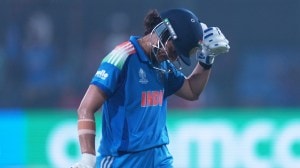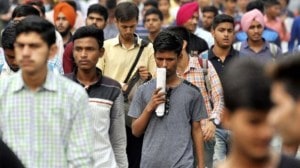🚨 The Indian Express UPSC Essentials brings to you the August edition of its monthly magazine. Click Here to read. Share your views and suggestions in the comment box or at manas.srivastava@indianexpress.com🚨
Explained
UPSC Syllabus:
Preliminary Examination: Current events of national and international importance
Story continues below this ad
Mains Examination: GS-III: Achievements of Indians in science & technology; indigenisation of technology and development of new technology
What’s the ongoing story- India’s second nuclear submarine, the Arighaat, was commissioned into the Indian Navy on Thursday at Visakhapatnam. The submarine has undergone extensive trials over the last few months.
Prerequisites:
— What are the nuclear submarine projects of India?
— What is India’s “no-first-use” policy?
Key takeaways:
— The 6,000-tonne INS Arighaat will join its predecessor, the nuclear submarine INS Arihant, as a key component of the India’s nuclear triad, which refers to a country’s ability to launch nuclear missiles from platforms in the air, land, and at sea.
— India is part of a select group of countries with nuclear triad capabilities, which includes the United States, Russia, China, and France. The induction of INS Arihant into the Navy in 2016 provided India with maritime strike capability for the first time.
Story continues below this ad
— The commissioning of INS Arighaat will enhance the Navy’s nuclear strike capability. The nuclear-capable Agni 2, Agni 4, and Agni 5 missiles can be launched from land, and fighter aircraft of the Indian Air Force such as the Rafales, Su-30MKIs, and Mirage 2000s can deliver nuclear warheads.

— The nuclear-propelled Arighaat will be armed with indigenously built K-15 missiles, with a range of more than 700 km. Like Arihant, Arighaat is powered by 83 MW pressurised light-water nuclear reactors, which allow it to remain submerged and undetected for much longer than conventional diesel-electric submarines.
— Under its “No first-use” policy, India is committed to using nuclear weapons only for deterrence and retaliation. With its ability to survive a nuclear attack and then launch a retaliatory strike, a nuclear sub acts as a very strong deterrent.
— The Indian Navy also has 16 conventional submarines in service — seven Kilo (Sindhughosh) class, four Shishumar class, and five French Scorpène (Kalvari) class attack submarines.
Story continues below this ad
— To carry out its full spectrum of operations, the Navy is authorised to have 18 submarines, a milestone that has been achieved with the commissioning of INS Arighaat. However, at any time, around 30 per cent of the fleet is under refit (repair and renovation), which brings down the strength of operational submarines.
For Your Information:
— About Arihant: India’s nuclear-powered submarine project was initiated more than three decades ago, involving both private firms and the Defence Research & Development Organisation (DRDO), with help from Russia. Arihant was launched in 2009, and commissioned into the Navy in 2016 as its first nuclear-powered submarine.
— Arighaat, like Arihant, is an SSBN. Nuclear- powered submarines are of three kinds. The one that carries conventional weapons is called an SSN in NATO terminology. The second, is capable of carrying guided missiles with conventional warheads-an SSGN. The third, and typically the largest and most complex, is the one that can carry ballistic missiles that may be nuclear armed SSBN.
Points to Ponder:
— What are the features of the Ballistic Missile Submarines (SSBNs)?
Story continues below this ad
— What is the significance of Arighaat in India’s national security matrix?
— What are the advantages and disadvantages of the nuclear submarine?
Post Read Question:
(1) Consider the following countries:
1. India
2. France
3. Russia
4. China
5. USA
Which of the following countries have nuclear triad capabilities?
(a) 1, 3 and 5
(b) 2, 4 and 5
(c) 2, 3, 4 and 5
(d) 1, 2, 3, 4 and 5
Other Important Articles Covering the same topic:
India gets second nuclear submarine with commissioning of INS Arighaat
UPSC Syllabus:
Preliminary Examination: Current events of national and international significance
Story continues below this ad
Mains Examination: GS-II, III: Government policies and interventions, Intellectual Property Rights (IPRs)
What’s the ongoing story- The Tamil Nadu government, last week, announced that the collected works of former Chief Minister M Karunanidhi would be “nationalised” – making them freely available for the public to publish, translate, and adapt.
Prerequisites:
— What is copyright?
— What are the copyright laws in India?
Key takeaways:
— Copyright laws: Under the Copyright Act, 1957, an author has a bundle of legal rights including the right to reproduce, issue copies, perform, adapt, or translate the work in question. Upon the death of the author, the ownership of the copyright falls to her legal heirs.
— Section 18 of the Act allows a copyright owner to “assign” the copyright “wholly or partially” to anyone she pleases, in return for compensation.
Story continues below this ad
— A copyright for any literary, dramatic, musical or artistic work remains in place until 60 years after the original author’s death. After this, the work enters the “public domain”, meaning can be used freely without permission from the for- mer copyright owners.
— Nationalisation of copyright: In 2001, the Tamil Nadu government established the Tamil Virtual Academy (TVA) to provide online education in Tamil language. The TVA has a scheme in which it collaborates with legal heirs of original copyrights to make them assign the rights to specific works to the state government.
— The Tamil Nadu government has, till date, nationalised the works of 179 Tamil scholars, and has paid Rs 14.42 crore in royalties to their heirs, the government said.
— Case of Ambedkar’s works: Prakash Ambedkar, the grandson of Dr BR Ambedkar, granted the copyright for Dr Ambedkar’s works to the Maharashtra government in the 1960s. In 1976, the state government established the Dr Babasaheb Ambedkar Source Material Publication Committee which published the first volume of Dr. Ambedkar’s works in 1979…
Story continues below this ad
— In 2016, Prakash refused to give permission for republishing these works to the Centre. He claimed that the copyright had not lapsed as the first volume of Dr Ambedkar’s works was only published in 1979.
— The Centre countered saying since 60 years had passed since Dr Ambedkar’s death, the copyright had indeed lapsed. The Centre published Dr Ambedkar’s works in 2018, ignoring his grandson’s claims.
Points to Ponder:
— What are the different types of IPR?
— What is the difference between trademarks and copyrights?
— How are IPRs protected at the national level?
Post Read Question:
Prelims
(2) Consider the following statements: (UPSC CSE 2019)
1. According to the Indian Patents Act, a biological process to create a seed can be patented in India.
2. In India, there is no Intellectual Property Appellate Board.
3. Plant varieties are not eligible to be patented in India.
Which of the statements given above is/are correct?
Story continues below this ad
(a) 1 and 3 only
(b) 2 and 3 only
(c) 3 only
(d) 1, 2 and 3
Mains
In a globalized world, Intellectual Property Rights assume significance and are a source of litigation. Broadly distinguish between the terms—Copyrights, Patents and Trade Secrets. (UPSC CSE 2014)
Other Important Articles Covering the same topic:
Delhi HC protects Anil Kapoor’s personality rights: What they are, how have courts ruled
Economy
UPSC Syllabus:
Preliminary Examination: Current events of national and international importance
Mains Examination: GS-III: Economy
What’s the ongoing story- The Directorate General of Trade Remedies (DGTR) under the Ministry of Commerce and Industry on Friday recommended the imposition of an anti-dumping duty on aluminium foils imported from China, after observing that Chinese imports had captured 30 per cent of the Indian market despite sufficient domestic capacity.
Prerequisites:
— What is anti-dumping duty?
— What is the impact of dumping on India’s economy?
Key takeaways:
— Anti-dumping investigations are conducted by countries to determine whether domestic industries have been harmed due to a surge in cheap imports. The Ministry of Finance makes the final decision on whether to impose duties.
— The DGTR stated that imports of “aluminium foil up to 80 microns, excluding aluminium foil below 5.5 microns for non-capacitor applications,” are undercutting the prices of the domestic industry. This price undercutting has forced the domestic industry to reduce its selling price below the cost of production, the DGTR said.
— The industry warned that an anti-dumping duty would increase the cost of downstream finished goods, making the Indian downstream industry unviable. Moreover, imports of finished goods from other countries would increase, causing injury to the flexible packaging industry in India.
— Despite several efforts to curb imports from China, goods are increasingly making their way from the neighbouring country. Imports from China have already crossed $60 billion during the first seven months of 2024, which is 10 per cent higher than the $55 billion recorded during the same period last year.
For Your Information:
— Dumping is an unfair trade practice that occurs when goods are exported from one country to another at a price lower than their normal value. DGTR investigates cases of anti-dumping brought forward by industry players and recommends an ADD and the margin of duty in case of a consequential serious injury to the domestic industry.
— CBIC has to accept or refuse DGTR’s ADD recommendation within three months from the date of the final hearing. The imposition of anti-dumping duties is a legitimate trade remedial measure under the World Trade Organization (WTO) rules.
Points to Ponder:
— What is the difference between Anti-Dumping Duty and Countervailing Duty?
— What are the pros and cons of anti-dumping duty?
— What are the steps taken by India to decrease imports from China?
Post Read Question:
(3) Which of the following best describes the term ‘import cover’, sometimes seen in the news? (UPSC CSE 2016)
(a) It is the ratio of value of imports to the Gross Domestic Product of a country
(b) It is the total value of imports of a country in a year
(c) It is the ratio between the value of exports and that of imports between two countries
(d) It is the number of months of imports that could be paid for by a country’s international reserve
Other Important Articles Covering the same topic:
Govt clamps down on dumping from China: Over 1/3rd anti-dumping duties levied in cases with sole or two producers since FY22
UPSC Syllabus:
Preliminary Examination: Current events of national and international importance
Mains Examination: GS-III: Economy
What’s the ongoing story- The decline in orders from Bangladesh has had a spillover effect on the Indian textile industry, which supplies raw materials and other input items to Bangladesh. While fresh inquiries for garments are coming to India, Indian cotton exports to Bangladesh have begun to decline, industry executives said.
Prerequisites:
— Why is Bangladesh given the status of the least developed country (LDC)?
— What is the PM Mitra scheme?
Key takeaways:
— Ahmed stated that much of the production is taking place in Dhaka and Chittagong, which are relatively isolated from the protests. There were disruptions earlier in August, but normalcy is returning, he said, adding that Western orders will eventually resume due to the favourable duty climate owing to Bangladesh’s status as a least developed country (LDC).
— Chatterjee mentioned that garment inquiries are coming in, but the immediate impact on the Indian textile industry has been negative since our exports of input materials to Bangladesh have slowed down. However, our PLI scheme and PM Mitra scheme are steps in the right direction to cater to national demand, she added.
— The Bangladeshi textile and garment industry, which accounts for over 80 per cent of Bangladesh’s total export earnings and contributes approximately 11 per cent to the nation’s GDP.
— Bangladesh’s $45 billion clothing industry, which employs over four million workers, was already affected due to the weakening electricity generation infrastructure, hit by higher input costs following the start of the Russia-Ukraine war and adverse weather events, according to S&P Global.
For Your Information:
— In trade terms, Bangladesh is India’s biggest partner in the subcontinent, and India is Bangladesh’s second biggest partner in Asia after China. Their total bilateral trade amounted to $13 billion in the financial year 2023-24, according to the Union Ministry of Commerce.
— Bangladesh is the biggest export destination for India’s cotton, accounting for 34.9% of India’s total cotton exports (some $2.4 billion in FY24). Other major Indian exports to Bangladesh are petroleum products and cereals.
— India’s top import from Bangladesh are readymade garments, amounting to $391 million in FY24. In recent years, Bangladesh has emerged as a major global hub for textiles.
Points to Ponder:
— What is the impact of the Bangladesh crisis on the Indian textile sector?
— What is the status of trade ties between India and Bangladesh?
— What are the initiatives introduced by the government to boost the textile sector in India?
Post Read Question:
(4) Consider the following statements: (UPSC CSE 2020)
1. The value of Indo-Sri Lanka trade has consistently increased in the last decade.
2. “Textile and textile articles” constitute an important item of trade between India and Bangladesh.
3. In the last five years, Nepal has been the largest trading partner of India in South Asia.
Which of the statements given above is/are correct?
(a) 1 and 2 only
(b) 2 only
(c) 3 only
(d) 1, 2 and 3
Other Important Articles Covering the same topic:
How Sheikh Hasina’s ouster may impact India-Bangladesh trade ties
Express Network
UPSC Syllabus:
Preliminary Examination: Indian Polity and Governance
Mains Examination: GS-II: Government policies and interventions for development in various sectors and issues arising out of their design and implementation
What’s the ongoing story- After Tamil Nadu Chief Minister M K Stalin wrote to Prime Minister Narendra Modi earlier this week asking the Centre to expedite the release of its share to the state under the Samagra Shiksha scheme, Education Minister Dharmendra Pradhan responded Friday urging him to sign a Memorandum of Understanding (MoU) with the Centre for the PM SHRI scheme.
Prerequisites:
— What is the PM SHRI scheme?
— What is the Samagra Shiksha scheme?
— What is the National Education Policy (NEP) 2020?
Key takeaways:
— On the Centre-State tussle over the implementation of the PM SHRI scheme, which aims to set up “exemplar schools” that will showcase aspects of the NEP, Pradhan wrote that Tamil Nadu had given an undertaking in March indicating the state’s willingness to sign the PM SHRI MoU for the 2024-25 academic year, and a draft MoU was sent by the Ministry of Education to the state.
— On the issue of language, Pradhan wrote in his letter to Stalin: “NEP 2020 emphasises that wherever possible, the medium of instruction until at least grade 5 but preferably till grade 8 and beyond will be the home language/mother tongue/local language/regional language. Therefore, NEP 2020 fully supports the idea of teaching Tamil in the schools of Tamil Nadu…”
— Three other Opposition-ruled states — West Bengal, Punjab and Delhi — had also not signed the MoU for PM SHRI and the Centre had not released funds to these states for the Samagra Shiksha scheme.
— One of the provisions of the MoU that states are to enter into with the Centre for PM SHRI is that the state will implement all provisions of the NEP 2020 “in entirety within the entire State/UT.”
For Your Information:
— The scheme, approved in 2022, seeks to develop 14,500 schools to “showcase” the National Education Policy (NEP), 2020, and be “exemplars” for other schools in their region. The scheme is for existing elementary, secondary, and senior secondary schools run by the central government and state and local governments around the country.
Points to Ponder:
— What is the language policy under NEP?
— Centre-State tussle on the question of Education policy
— What are the concerns of the states regarding the NEP?
Post Read Question:
Prelims
(5) Which of the following provisions of the Constitution does India have a bearing on Education? (UPSC CSE 2012)
1. Directive Principles of State Policy
2. Rural and Urban Local Bodies
3. Fifth Schedule
4. Sixth Schedule
5. Seventh Schedule
Select the correct answer using the codes given below:
(a) 1 and 2 only
(b) 3, 4 and 5 only
(c) 1, 2 and 5 only
(d) 1, 2, 3, 4 and 5
Mains
Discuss the main objectives of Population Education and point out the measures to achieve them in India in detail. (UPSC CSE 2021)
Other Important Articles Covering the same topic:
What is PM SHRI, the ‘showcase’ schools scheme that Centre is pushing in states?
Govt & Politics
UPSC Syllabus:
Preliminary Examination: Current events of national and international importance
Mains Examination: GS-II: Government policies and interventions
What’s the ongoing story- Stressing on the importance of a zero-tolerance approach towards crime against women, Vice-President Jagdeep Dhankhar on Friday said that implementing a Uniform Civil Code (UCC) would be a step forward to ensure justice for women.
Prerequisites:
— What is the Uniform Civil Code (UCC)?
— What are the constitutional provisions related to UCC?
Key takeaways:
— Mentioning that the UCC was in the Directive Principles of State Policy, the V-P said: “…the UCC, which has been on the shelf for too long, is a small measure of justice for your segment. Look around and see what it means. It will help in several ways, but mainly it will help your gender.”
For Your Information:
— The promise to pass the UCC stems from Article 44 of the Constitution of India — a directive principle saying, “The State shall endeavour to secure for the citizens a uniform civil code throughout the territory of India.” This Article was adopted by the Constituent Assembly on November 23, 1948, after a spirited debate.
— In his latest Independence Day speech, Prime Minister Narendra Modi had made a fresh push for a common code asserting that a “secular civil code” is the need of the hour for the country. He also described the existing set of laws as “communal civil code” and termed them discriminatory.
— The term of the 22nd Law Commission, which is without a chairperson for the past few months, ends Saturday(31st August 2024) with its key report on the uniform civil code still in works.
Points to Ponder:
— What are the arguments in favour and against the UCC?
— What are the important cases related to UCC?
— What are the challenges in the implementation of UCC?
Post Read Question:
Discuss the possible factors that inhibit India from enacting for its citizens a uniform civil code as provided for in the Directive Principles of State Policy. (UPSC CSE 2015)
Other Important Articles Covering the same topic:
How the Uniform Civil Code came to be included in the Indian Constitution
Term of 22nd law panel ends Saturday, report on UCC still in works
UPSC Syllabus:
Preliminary Examination: Economy
Mains Examination: GS-II, III: Government policies and interventions, Economy
What’s the ongoing story- Union Minister of Home and Cooperation Amit Shah Friday urged Uttarakhand farmers to adopt organic farming. He was speaking on the occasion of signing of an MoU between National Co-operative Organics Ltd (NCOL) and Uttarakhand Jaivik Utpad Parishad for procurement of organic cereals to provide better rates to farmers for their produce.
Prerequisites:
— What is organic farming?
— What is the significance of organic farming?
Key takeaways:
— Shah said that Prime Minister Narendra Modi has set a goal of doubling farmers’ income, of which one of the points was to increase income through organic farming. Shah said that chemical fertilizers not only affect human health but also have an impact on farm land. Due to excessive use of fertilizers, the soil loses its fertility, he said.
— Shah said NCOL, set up to address gaps in the organic farming sector, plans to establish a network of testing labs in collaboration with Amul. These labs will verify both organic farms and produce, aiming to create trusted ‘Bharat’ organic brands.
For Your Information:
— Last year, Tamil Nadu government has rolled out the organic farming policy towards ‘chemical-free organic agriculture’ in the state.
— Some of the advantages of organic farming is that it improves and sustains oil fertility while minimising the use of off-farm resources.
— “Organic farming creates harmonious balance between crop production and animal husbandry and facilitates alignment of life with natural ecosystems and cycles. It also supports self-reliance and sustainability in farming,” the policy document said.
— On the need for organic farming, the policy said many health issues noticed across the world were found to be residues of agro-chemicals. It has been proven that pesticide residues cause many health hazards to humans and animals.
— The World Health Organisation (WHO) is promoting ‘One Health’ which necessitates organic farming to improve soil health.
Points to Ponder:
— What are the methods of sustainable agriculture?
— What are the methods of sustainable agriculture?
— What are the government initiatives related to organic farming in India?
Post Read Question:
(6) With reference to organic farming in India, consider the following statements:
1. ‘The National Programme for Organic Production’ (NPOP) is operated under the guidelines and directions of the Union Ministry of Rural Development.
2. ‘The Agricultural and Processed Food Products Export Development Authority (APEDA) functions as the Secretariat for the implementation of NPOP.
3. Sikkim has become India’s first fully organic State.
Which of the statements given above is/are correct?
(a) 1 and 2 only
(b) 2 and 3 only
(c) 3 only
(d) 1, 2 and 3
Other Important Articles Covering the same topic:
Tamil Nadu unveils organic farming policy with focus on promoting chemical-free agriculture
Sustainable agriculture for climate resilience and food security
| PRELIMS ANSWER KEY |
| 1. (d) 2. (c) 3. (d) 4. (b) 5. (d) 6. (b) |
Subscribe to our UPSC newsletter and stay updated with the news cues from the past week.
Stay updated with the latest UPSC articles by joining our Telegram channel – Indian Express UPSC Hub, and follow us on Instagram and X.
https://www.youtube.com/watch?v=MNesF36gKu4?si=5iuZjcvCy6i5b_kc&w=560&h=315



































